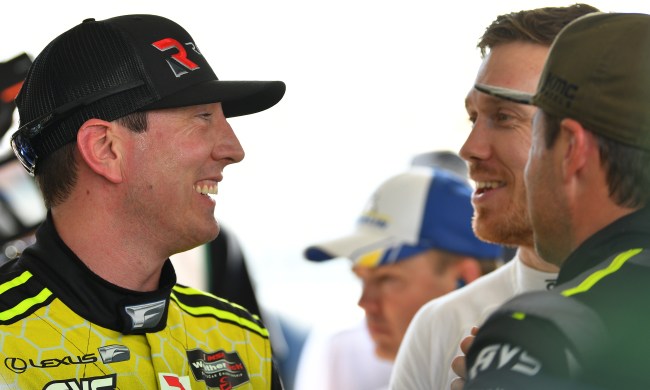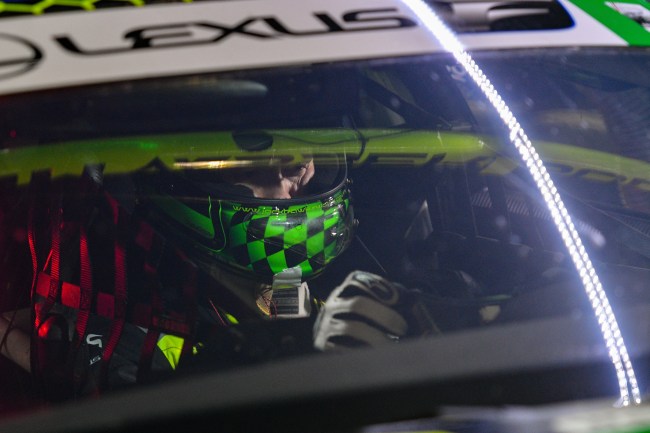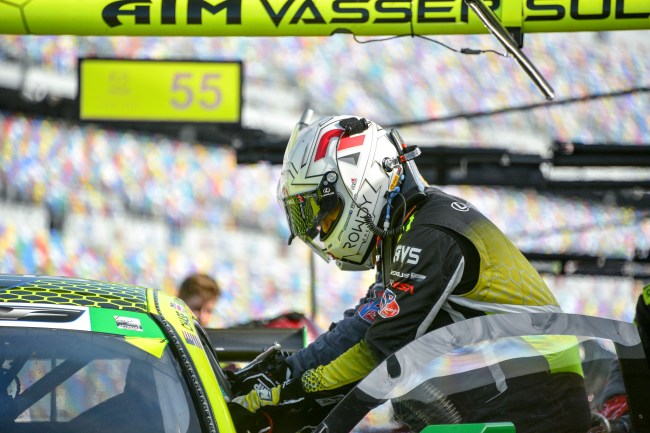
Lexus Racing/Sideline Sports Photography
Presented in partnership with Lexus Racing
Every day, talking heads who possess the acumen to convince someone to pay them to talk about sports for a living spend hours on end spouting takes of varying temperatures at unreasonable decibel levels on television programs and radio shows, where they fiercely engage in debates over trivial questions that usually don’t have an objective answer.
Of course, there are countless people who do the exact same thing on a daily basis without being compensated by a media conglomerate, whether they’re in a barbershop arguing about if LeBron James or Michael Jordan will have a better legacy in the exact same chair they’ve had that conversation in a dozen times before or spending their entire night on Twitter going back and forth with a total stranger about the physics behind Deflategate even though it happened five years ago.
However, during my time wasting far too many hours of my life traversing the internet and repeatedly failing to resist the urge to see what Stephen A. Smith has to say about whatever issue has sparked his ire on any particular day, there’s one argument that rears its ugly head again in again: what constitutes a “real” sport.
Every four years, the world is reminded that curling is a thing when the Winter Olympics roll around and everyone convinces themselves they could just as easily grab a broom out of the closet and suddenly compete on an international stage.
There are also plenty of people who don’t view golfers as true athletes and would argue leisurely walking 18 holes and occasionally swinging a club while someone lugs your bag for you isn’t the most physically demanding activity in the world.
With that said, I’d argue no one has to deal with more disrespect than the drivers who are tasked with hopping behind the wheel of a car and traveling at absurd speeds for hundreds of miles while a sizeable chunk of the population is of the opinion that the only prerequisite required to compete in the world of auto racing is the ability to turn left.
Anyone who is remotely familiar with the sport knows just how patently absurd that argument is, as taking part in a race is slightly more physically grueling and mentally demanding than going 85 MPH for a few seconds so you can pass a tractor-trailer while going around a bend in the highway.
As for the left turn thing? That criticism doesn’t have much merit at the Rolex 24, an annual endurance race that takes place on the road course at Daytona International Speedway, where drivers are tasked with completing as many laps as possible between the time the green flag waves on Saturday afternoon until the checkered one makes an appearance exactly 24 hours later.
In January, I got the chance to head down to Daytona to witness the Rolex 24 firsthand alongside the Lexus Racing USA team, and while I was thrilled to get a chance to escape the dreary weather in New York City, I was a bit hesitant to make the trek thanks to one minor detail: I knew virtually nothing about auto racing.
However, I ultimately accepted the invitation and spent a week or so giving myself a crash course in the sport so I could at least act like I belonged at the first race I attended since I went to an event at a half-mile track in Connecticut when I was in elementary school because admission was free for kids under 12 and they were having fireworks that night.
A sizeable chunk of that research involved Googling acronyms I’d never heard of, such as IMSA, which stands for the International Motor Sports Association, the body that governs the world of sports car racing and kicks off its season by coming in hot with the most demanding race drivers will compete in during the entire year.
If you’re as clueless as I was about this particular sphere of racing when I was first introduced to it, I’ll do what I can to get you up to speed.
Races that are overseen by IMSA—which is owned by NASCAR—don’t feature the stock cars the general public is most familiar with. Instead, they showcase four different classes of varying performance ability—all required to meet specific regulations that are much too complex to get into here.
The classes are broken into two tiers, with the first one home to sports prototypes designed to showcase the best technological innovations the automotive world has to offer. The fastest cars on the track belong to the Daytona Prototype International (DPi) followed by the Le Mans Prototype 2 (LMP2).
Strap in, folks. We’re not done with the acronyms quite yet.
You then have the two types of cars that comprise the Grand Touring classes. The first are the GT Le Mans (GTLM), which are based on production models but are more souped-up than the GT Daytona (GTD) class, which also features cars you can buy off the line but which must abide by stricter rules concerning modifications.
This year, AIM VASSER SULLIVAN, the racing team that partnered with the manufacturer in 2018, traveled to Daytona with a couple of Lexus RC F GT3 cars in tow.

Lexus Racing/Sideline Sports Photography
In addition to helping with the optimization of the RC F model that raced at the Rolex 24, AVS also aided in assembling the crew tasked with maintaining and manning the cars that would be pushed to the limit as Lexus tried to earn a spot on the podium for the second year in a row.
This year, the Lexus team added a very notable member to their roster in the form of Kyle Busch, who announced he’d be taking his talents to the Rolex 24 just a couple of weeks before he secured his second NASCAR Cup Series championship.
David Wilson, the head of the Toyota Racing Development and who has played a major role in the rapid rise of the Lexus racing branch, said the partnership was a long time in the making but that Busch was the perfect candidate to add to a list of some legendary drivers who have made a similar pivot:
“The nature of IMSA presents some unique opportunities for all-stars from other forms of motorsports. We’re not the first to do this. You’ve got Jimmie Johnson and Jeff Gordon and Dale Earnhardt Jr.
We started tracking our Cup drivers’ progress and their abilities on road courses. I would say Kyle is one of the best NASCAR drivers in the arena.”
He noted some drivers are hesitant to do what Busch did because their hubris prevents them from taking part in a race where they aren’t the first car to finish overall, which you might think could have served as a major barrier to entry if you’re familiar with Busch’s competitive spirit:
“You have to set aside your ego when you’re in the slowest class. Kyle is not used to getting passed. He’s going to get passed more in these 24 hours than he will the entire NASCAR season.”
However, Wilson stressed Busch checked his ego at the door and dove headfirst into his new role:
“At the Roar Before the 24 [a prerace event at Daytona in early January], Kyle participated from the very first practice on Friday to the very last practice on Sunday night. He then spent two or three days in our shop in North Carolina spending hours in the simulator and doing it again and again.”
I got the chance to sit down with Busch and a couple of other members of the AIM VASSER SULLIVAN team before the race kicked off to try to figure out exactly what it takes to endure an entire day and night on the track and, well, it turns out it’s exactly as taxing as you’d think.
Busch said he gave himself about a month to relish his Cup championship before turning his attention to the Rolex 24 in mid-December, which is when he visited the aforementioned facility in North Carolina to ease himself into his new role with some virtual experience on the simulator.
Busch had previously driven a prototype on the road course at Daytona in the Brumos Porsche 250 in 2008 before competing on the oval in the Coke Zero 400 later that night.
As a result, he’s no stranger to testing his endurance in the cockpit but he’d never raced a GTD car prior to this year and said he felt that experience over a decade ago didn’t have much of an influence in preparing for the Rolex 24—especially when you consider the difference between the car he drives in NASCAR and the Lexus he had to navigate around the 3.2-mile track:
“There’s the weight of the car and the stopping power of the car. The brakes are bigger, the car’s lighter, and there’s ABS so you can drive the heck out of it and rely on the car to do its job versus a Cup car. You really have to finesse and control it.”
He added that he didn’t have to change his approach much compared to a NASCAR race but needed a bit of a crash course of his own based on his relatively late introduction to his new team:
“There’s way more work so far that’s gone into this than there is in a typical Cup weekend just with everything going on. The team debriefs and there’s so much data but not a whole lot of time to review it.”
Busch has earned quite a reputation for how he handles himself both on and off the track and is known for his aggressive driving style, so he also had to suddenly deal with the reality of being on a track surrounded by cars capable of leaving the RC F and other GTDs in their dust.
However, he didn’t seem overly concerned about having to make that adjustment:
“I don’t care about the other classes. The only thing I care about is our class. Yes, there’s going to be faster cars out there and there are going to be cars that are capable of much greater things than you are. You just make sure you get out of their way and it’s over with.”
Given his relative inexperience in the IMSA world, Busch also had to rely a fair amount on the other three men driving the No. 14 car with him on race weekend. Each team has two professional drivers and two amateurs at their disposal, all of whom must race at least four-and-a-half hours over the course of the event (the less experienced ones usually take the earlier shifts and let the pros take over as the race gets closer to its end).
Busch’s fellow pro was Jack Hawksworth, a British racer who pivoted from driving in IndyCar to IMSA (before also testing his luck in NASCAR) and has competed in the Rolex 24 six times, with four of those featuring him behind the wheel of the Lexus RC F.

Lexus Racing/Sideline Sports Photography
Busch gave Hawksworth a sizeable chunk of the credit in helping him to prepare for the race, saying:
“I pretty much just rely on Jack. Jack’s the most experienced guy. He’s been with this program since it started over here so he’s been the one to lean on.”
However, Hawksworth gave some credit of his own to Busch for his ability to digest information almost instantaneously:
“Kyle’s a sponge. He’s a very clever guy. He hasn’t been doing this long but you can just tell he takes in information and translates it onto the track.”
Townsend Bell, the seasoned veteran who helped drive the No. 12 Lexus that AVS also entered into the Rolex 24, agreed with this sentiment.

Lexus Racing/Sideline Sports Photography
However, he admitted there was a bit of a language barrier, as Busch had a tendency to throw out some terms unique to NASCAR when trying to explain certain issues he experienced:
“He’s super in tune with what he’s feeling. The way he delivers his feedback is sometimes with terminology that we’ve never heard before. There are some terms that have come out that we have no idea initially what he’s talking about but we eventually manage to translate it.”
Bell also notes the transition wasn’t entirely seamless:
“Kyle knows he needs help but he doesn’t always want to admit he wants help because he’s so successful at what he does. But there’s also a big body of knowledge he doesn’t have.”
Hawksworth noted another slight road bump was encountered after Busch had trouble coming to terms with some of the rules IMSA forces teams to follow:
“I also think he believes the regulations are very, very open and that we can just start
building new parts for the car. We can’t do that.”
Jimmy Vasser, the retired IndyCar champion who lends his name to the team he helps manage, is no stranger to this particular endurance race, as he competed in the Rolex 24 multiple times over the course of his career. However, he shied away from trying to get too deep into the weeds when it came to helping Busch get up to speed:
“I think people assume that I’m just telling everybody how to do it or what to do because I did it before and say ‘You better listen to me’ because I’m the boss. That’s just not my style. I’m here to let everybody know that I’m here to help if you have any questions. That’s really been my approach.”
What I was most curious about, however, is how you even begin to sort out the logistics that come with taking part in one of the most demanding events in auto racing while ensuring you stay at the top of your game for an entire 24 hours.
Busch said the powers that be in the pit largely determine how long the guys continually navigate around the track and pick who will take the next shift.

Lexus Racing/Sideline Sports Photography
However, each of the drivers has their own strategy when it comes to waiting for their next shift at the wheel and some guys will get a massage or jump on an exercise bike in addition to getting some sleep (doing so with the knowledge they could be violently shaken awake and told that they’re needed immediately at any point).
It’s hard to truly appreciate what it takes to make it through a race that lasts an entire day and night and AVS co-owner James “Sulli” Sullivan summed up how much of a grind it can be:
“Jimmy and I’s idea of an endurance race was the Indy 500. Here, you wake up at 8:30 in the morning and you realize you still have to race for the same amount of time a full 500 takes.”
Both Busch and Hawksworth said they had plans to retire to a comfortable bed in one of the many RVs parked adjacent to pit row following their time in the Lexus but Bell decided to make things a bit more difficult for himself by deciding to stop by the NBC booth to contribute to the broadcast during the race (when asked why, he credited his two kids and the mortgage he has).
The Rolex 24 may have been a bit of a departure for Busch, but even though he had yet to compete in it when I talked to him, he said he’s already looking for other opportunities to branch out and has set his sights on some other notable events:
I would’ve gone to Le Mans this year but the weekends don’t work. I would like to do some things like that. I’ve kind of always said the Indy 500 would be a possibility. Going and doing the Dakar Rally certainly sounds cool. Running the Baja 1000. So some of that stuff.
When everything was said and done, Busch and the rest of the team that piloted the No. 14 Lexus car left Daytona with a top-ten finish. It’s still too early to tell if he’ll be coming back for another year, but when you consider he shares a similar philosophy with Ricky Bobby when it comes to his views about not finishing first, don’t be too shocked if you see him take on Daytona for 24 hours again.